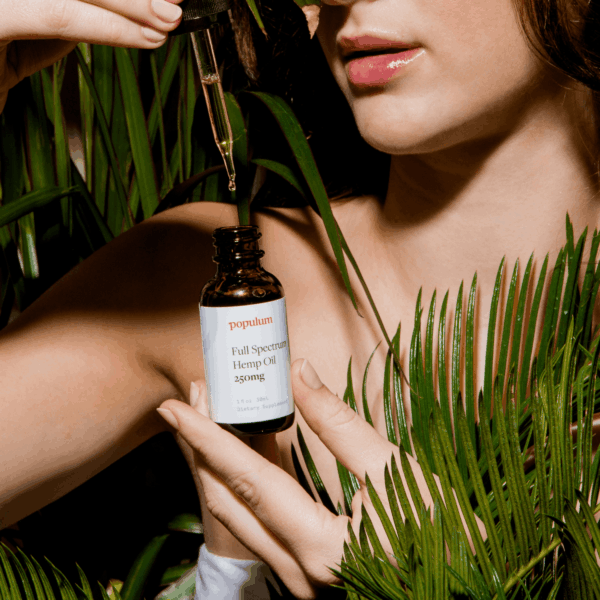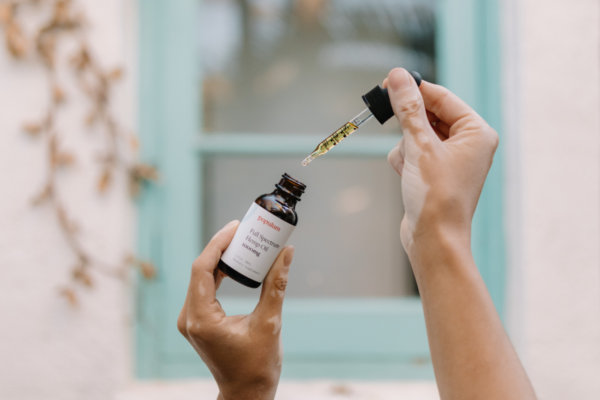How CBD Oil Is Made: A Step-By-Step Overview
by Taylor Hogan
CBD popularity has exploded. According to SingleCare, 33% of American adults have tried CBD. With over a third of Americans giving the supplement a try, many may wonder where the popular supplement comes from.
First, before diving into how CBD is made, let's clear up the confusion between hemp and marijuana. Both hemp and marijuana are forms of cannabis, but in order for a plant to be classified as “hemp” it needs to be grown under a hemp program and is required to contain less than 0.3% THC. Contrarily, “marijuana” plants contain more than .3% THC and are grown in recreationally or medically legalized states.
Because hemp contains less than .3% THC, it is non-psychoactive. Other than CBD, hemp has traditionally been used for centuries as a material for rope, fibers and textiles. We lay it all out in our History of Hemp article.
Populum’s CBD oil is made from refined hemp extract that has been combined with a carrier oil. Read through this to learn the step-by-step process on how CBD is made.

Step 1: Planting The Hemp Plant
Before the hemp seeds are sowed into the ground, the soil is prepared and tested for herbicides. Hemp is a pretty wonderful plant because each crop can be planted very closely together - as close as four inches! This allows for a greater yield with less land use. Hemp is an excellent resource for regenerative agriculture because it can be used in crop rotation to help put nutrients back into the soil. Hemp produces high quantities of biomass (a matter which returns to the soil and decomposes, feeding nutrients back into the ground).
According to Farm Journal, plant hemp typically falls between the third week of May and into the first week of June. Once planted, the hemp grows rapidly, sprouting up in 60 days. Cannabis Reports listed the states with the most hemp produced to be Montana, Colorado, Kentucky, North Carolina, Oregon and Minnesota.
Hemp is not a plant that is limited to just one region of the United States!

Feel Better with Populum CBD
The best CBD oil you can buy, backed by 900+ verified reviews. Try risk-free for 30-days.
Step 2: Harvesting The Hemp Plant
It all starts with the flowers of the hemp plant. The cannabinoids are most commonly concentrated in the resin glands of the trichome of the plant.
The plants are usually harvested around October, depending on the climate of the state. Before they can officially harvest, a sample of each crop is tested and cleared by the state’s department of agriculture. This is to assure that the farm is following federal regulations, keeping their hemp at <0.3% THC.
For instance, Populum works with farmers in eastern Colorado that are licensed by the Colorado Dept of Agriculture and follow organic farming standards, which ensures that no pesticides or heavy metals are present near the plants.
Once harvested, plants are put up to be cured, or air dry in a well ventilated area. This curing process takes 3-4 weeks. Once dried, the flowers, where you can find the strongest concentration of cannabinoids, are stripped from the plants and then shipped to manufacturers that then extract the cannabinoids.

Step 3: Extracting the CBD from the Dried Hemp Flower
Extraction is the process of removing the CBD extract from the hemp plant to turn it into a usable form for ingestion or topical application. Each extraction method results in a slightly different end result, but depending on how it’s extracted, the raw extract will have a thick oily texture with a very dark, almost black, hue.
There are different extraction methods and each has its own pros and cons. Here’s a short list of the top extraction methods available:
- Ethanol Extraction:
- This method involves soaking the plant in high-grain alcohol in order to extract the CBD oil. Ethanol extraction is now one of the most common methods of today’s high-quality natural extractions and is gaining traction as one of the most effective on the market.
- This method involves soaking the plant in high-grain alcohol in order to extract the CBD oil. Ethanol extraction is now one of the most common methods of today’s high-quality natural extractions and is gaining traction as one of the most effective on the market.
- CO2 Extraction:
- CO2 extraction uses carbon dioxide to isolate cannabinoids under extremely low temperatures. Super-cooled and condensed carbon dioxide cools and then extracts CBD oil without leaving any chemicals or residue behind. This process requires robust equipment, but yields a safe and potent end product.
- Oil Extraction:
- Another method is the oil method, which is popular with at home and do-it-yourself folks. In this method, the hemp plant is heated and cooked in a carrier oil such as olive oil which extracts the desired cannabinoids.
Populum uses a two-step extraction methodology that combines Food-Grade Ethanol Extraction and a Fractionalized Distillation. This method cleans the oil of all waxes, lipids, and chlorophyll, to create a true full-spectrum oil that includes both high levels of cannabinoids and terpenes.
Step 4: Creating CBD Oil & Topicals
Once CBD is in its purest form and extracted from the plant, it is combined with other ingredients such as flavoring and carrier oil. For example, Populum uses a special blend of grapeseed, hemp seed and orange oil. Oils such as hempseed or coconut (MCT) oil make for excellent carriers for full-spectrum CBD. This is due to its natural abundance in saturated fats. Natural saturated fat molecules are easily absorbed by the body and directly through the liver. This allows for the body to get the most CBD absorbed into the bloodstream as possible. Populum also uses cold-pressed orange oil in their CBD oil for a light orange taste, which helps negate the “hempy” or “earthy” taste many hemp oils have.
Step 5: Lab Testing & Packaging
Populum undergoes third-party testing with each of its batches of CBD. A sample from each batch is sent to a lab, where it is tested for purity and potency. Third-party testing is the differentiator between good quality CBD products and products that could be anything labeled as CBD. This extra process in production makes all the difference when it comes to making a quality product.

The entire process of producing a quality CBD oil takes several steps, but having a direct and clear supply chain helps yield quality end products. Brands who are transparent about their methods of production and consistently third-party test their products are often the brands providing the best oils on the market. The CBD industry has a long history, but within the past few years the technology advancements have made way for a better end product. Better production methods and continued innovation means CBD oil can make its way to more and more people and bring healing into the lives of many.


